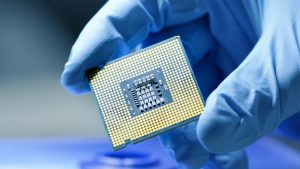The coated microchip, known as an infrared imaging array, is the creation of QDIR which was incorporated in 2020 by Matthew Ackerman, a Chain Reaction Innovations (CRI) Cohort 4 innovator, and Philippe Guyot-Sionnest, a professor of chemistry and physics at the University of Chicago. Ackerman earned his Ph.D. and M.S. in physical chemistry from the University of Chicago.
“QDIR stands for ‘quantum dot infrared,’ since our core technology is built using quantum dot nanomaterials,” Ackerman said.
Ackerman joined CRI’s Cohort 4 at the U.S. Department of Energy’s (DOE) Argonne National Laboratory in June 2020. CRI is a two-year entrepreneurship program that embeds innovators in the Lab to help them grow their early-stage technologies. While embedded, Ackerman has worked with Benjamin Diroll, an Argonne scientist with expertise in colloidal nanocrystals.
Milestones for QDIR include transitioning capabilities from the University of Chicago to the tooling and equipment at Argonne, “which is not a small feat,” notes Ackerman, and sending samples for characterization and testing to an interested party.
In June 2021, QDIR received a National Science Foundation Small Business Innovation Research (SBIR) grant for $256,000.
How it Works
QDIR’s cutting-edge infrared imaging array acts as the sensor that creates the image in an infrared camera.
To create the infrared imaging arrays, QDIR purchases silicon microchips, roughly 1 cm by 1cm each, and coats the microchips with a colloidal suspension of HgTe quantum dots. The size of HgTe nanocrystals, ranging from a few to 20 nanometers, contained in the quantum dot ink coating is important because it impacts what wavelengths of infrared light can be detected.
The electrons in the nanocrystals are motionless in the dark, but once infrared light enters the camera the electrons in the HgTe coating are set in motion, creating an electric current. The silicon microchip then converts the electric current into an infrared image.

The HgTe quantum dot coating is a solution made in batches from inexpensive raw materials and painted onto the microchip. Competitors, however, mechanically bond an exotic absorbing material onto the silicon chip, which can result in a lower production yield, Ackerman pointed out.
Impact
Infrared cameras containing QDIR’s product can be used for defense (e.g., night vision and surveillance), as well as in industry and agriculture – such as removing bruised fruit, sorting out rocks mixed in with nuts, and identifying defective products.
Infrared has a longer wavelength on the electromagnetic spectrum than visible light and an infrared camera can detect what human eyes can’t see.
Technology Advantages
Infrared cameras play a central role in national security, enabling forces to identify potential threats and their intent over long ranges and under all visibility conditions. These cameras ensure a high degree of situational awareness—that is, accurate knowledge of surroundings and the ability to quickly react to changes in that environment.
Defense forces operating at night and at sea rely on long-range detection to identify potential threats quickly to afford maximum time to react. However, the ability to positively identify such a threat is limited by the resolving power of the camera. High-resolution infrared imaging affords more pixels on target, which means seeing more and better detail to enhance situational awareness.
“QDIR stands for ‘quantum dot infrared,’ since our core technology is built using quantum dot nanomaterials,” Ackerman said.
Making infrared cameras cost-effective means more “eyes”—or cameras—on target to ensure any blind spots are eliminated in high-risk situations. Cost-effective, high-resolution infrared cameras with infrared imaging arrays like QDIR’s would be deployable in swarms and fleets to create large sensor networks to reduce blind spots.
Additional Applications
Beyond defense, the same infrared sensors that QDIR is developing for national security can be used to make infrared cameras more cost-effective so they can enhance the safety of driver-assisted and autonomous vehicles under all lighting and weather conditions. Infrared sensors do not require a light source to detect objects. Instead, they detect the thermal infrared light emitted by warm objects like cars, animals, and people regardless of day, night, or weather conditions, making these sensors complementary to other autonomous driving systems such as LiDAR, radar, and GPS.
Furthermore, infrared cameras play an important role in infrastructure inspection, quality assurance, research, manufacturing, security, recycling, and medical industries. QDIR’s infrared imaging arrays will enable more cost-effective solutions to potentially address challenges such as identifying otherwise invisible wasted energy due to a poorly insulated building, the chemical composition of plastics for more effective recycling processes, and invisible gas leaks in chemical refining.
QDIR’s infrared imaging array is currently a prototype but is slated for the pilot phase within 6-12 months and is planned to be commercially available within 2-3 three years, Ackerman said.

